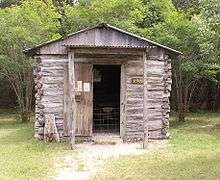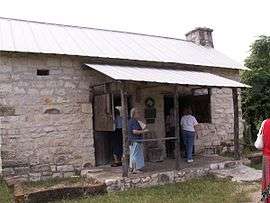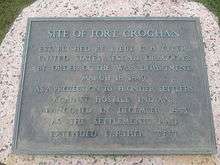Fort Croghan
Fort Croghan was the third of the first four forts established by the United States government to protect settlers from hostile Indians along the Texas frontier. From its establishment on March 18, 1849 by Lt. C.H. Taylor (Company A, Second Dragoons) until it was abandoned in 1855,[1] Fort Croghan was home to Company C, 8th Infantry, U.S.A. (mounted) and eventually became the headquarters of the Second Dragoon Regiment.
Fort Croghan | |
|---|---|
Historical Park Site | |
 Fort Croghan Outpost | |
 Location within Texas | |
| Coordinates: 30°45′25″N 98°14′15″W | |
| Country | United States |
| State | Texas |
| County | Burnet |
| U.S. Army Fort | March 13, 1849 |
| Elevation | 1,329 ft (405 m) |
| Time zone | UTC-6 (Central (CST)) |
| • Summer (DST) | UTC-5 (MDT) |
| GNIS feature ID | 1357583 |

Part of a chain of forts extending from Fort Worth to Fort Inge near present-day Uvalde, the fort was named for Colonel George Croghan. The fort originally covered some 50 acres (200,000 m2) near the present day city of Burnet, Texas, extending from Hamilton Creek up and over Post Mountain. Today a small section exists due to the efforts of the Burnet County Historical Society who raised money in the 1960s to purchase this portion of the old fort.[1]
Early history
In the 1840s, upon the annexation of Texas to the United States, the federal government became responsible for the protection of frontier settlers from Indian raids. Several companies of Texas Rangers, financed by the federal government, were stationed along the frontier. In December 1847, a company of Rangers under the command of Henry Eustace McCulloch took up a position about three miles (5 km) south of present-day Burnet. Samuel E. Holland purchased a 1,280-acre (5.2 km2) grant there in 1848, including the land on which the Ranger station was located. His residence built on that land is said to have been the first permanent home in Burnet County. 1.[2] The indigenous peoples of the Americas had occupied this region for thousands of years, but did not build or live in permanent homes, theirs being a migratory culture.
In the late 1840s, it became apparent that the lure of free and cheap land had thrust many settlers far beyond the protection of civilization.[3] More and more settlers arrived, many of them from foreign countries. Some came expecting to acquire good farmland near the Texas coast. They soon learned that they would have to move hundreds of miles inland and the only land left was marginal rangeland. Indians who had been peaceful due to treaties and the presence of the United States soldiers during the U.S.-Mexican War now began to come into conflict with these newcomers. The Comanche and Apache were particularly incensed at this intrusion into their ancient hunting grounds.
At first, the government wanted to build Fort Croghan near Holland Springs. Burnet County's first white resident, Sam Holland, objected strenuously to a military post being located near his home. It was then decided to locate the fort a few miles north on Hamilton Creek. There was no more important consideration than a year-round source of abundant clean water. Water was needed for many functions as well as drinking water for people and animals.
All the necessary buildings – including a hospital, bakery, officers' quarters, enlisted men's huts, powderhouse, horse and mule lots, blacksmith shop, storage buildings and a lookout building on top of Post Mountain – were constructed by the soldiers. In October 1849, Company C. 8th Infantry, U.S.A. Mounted arrived to occupy this newly constructed fort.
Fort Croghan consisted of the usual log cabins enclosed by a strong stockade. It was manned by one company of cavalry and one of infantry. The first commander was Captain Phillip St. George Cook. Captain Cook soon resigned his position and was followed by Captains; Blake, Lee and Sibley. Some of the soldiers settled in the area and stayed on after the Fort was decommissioned. Christian Dorbandt, later sheriff of Burnet County was one of these men.3.[4] Noah Smithwick worked as an armorer for the fort.[5]

A small town soon grew up across Hamilton Creek as merchants and other suppliers of services moved to be near the fort. Logan Vandeveer and Peter Kerr were among the first to obtain contracts to furnish the fort with beef and other foodstuffs. In 1852 Vandeveer was instrumental in petitioning the Texas Legislature to authorize the creation of Burnet County. The town was first called Hamilton or Hamilton Valley, but in 1858 the name was changed to Burnet also.
Fort Croghan was abandoned in December 1853, having served its purpose. The last building there was demolished in the 1920s and the old fort was forgotten as the town grew and prospered.
Fort Croghan Restoration
In the 1960s, a group of citizens interested in preserving this part of Burnet County and the city of Burnet's past formed the Burnet County Historical Society and raised the money to purchase the present day grounds. Early presidents of the Burnet County Historical Society included; Rethie Dorbandt, Ed Young, Virgil Lewis, Tad Moses, Jimsey Husted, Phyllis Adrian, Reta Ross, Clyde Mather, Mrs. T.D. Bryant, W.C. Galloway, Mather Dorbandt, and Donald Duncan. 4.[6] Local landowners donated the historical cabins which were moved to the fort grounds and reassembled exactly as they were.
Fort Croghan Grounds and Museum
The Fort Croghan Museum features historical artifacts including tools, household items and Western gear. The grounds contain restored buildings with period displays, including a stage stop house, blacksmith shop, school house, powder house, several late 19th century cabins, a lookout house and a syrup making shop. Fort Croghan Day is held each year to demonstrate frontier life.

See also
- The Texas Rangers' McCulloch's Station was four miles south on Hamilton Creek.[1]
- Fort Worth
- Fort Gates
- Fort Graham
- Fort Martin Scott
- Fort Inge
- Fort Duncan
References
- Crimmins, M.L., 1943, The First Line of Army Posts Established in West Texas in 1849, Abilene: West Texas Historical Association, Vol. XIX, pp. 121-127
- Darrell debo Burnet County History
- Frontier Forts > Texas and the Western Frontier
- Smithwick, Noah Evolution of a State Copyright 1900
- Smithwick, Noah (1900). The Evolution of a State, or, Recollections of Old Texas Days. University of Texas Press. p. 222. ISBN 978-0-292-72045-9.
- The Burnet Bulletin Newspaper Thursday July 26, 1973
External links
| Wikimedia Commons has media related to Fort Croghan. |
- Fort Croghan Grounds and Museum Facebook Site
- Fort Croghan Grounds and Museum - official site
- "Fort Croghan". Handbook of Texas Online. Texas State Historical Association.
- Fort Croghan Grounds and Museum - more information and history